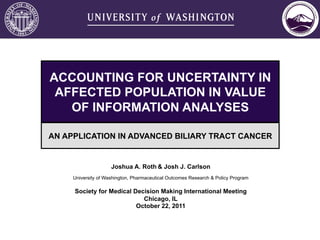
Roth_Society For Medical Decision Making Conference 2011-Accounting for Uncertainty in Affected Population in Value of Information Analyses
- 1. ACCOUNTING FOR UNCERTAINTY IN AFFECTED POPULATION IN VALUE OF INFORMATION ANALYSES AN APPLICATION IN ADVANCED BILIARY TRACT CANCER Joshua A. Roth & Josh J. Carlson University of Washington, Pharmaceutical Outcomes Research & Policy Program Society for Medical Decision Making International Meeting Chicago, IL October 22, 2011
- 2. Study Rationale & Objective • Value of information (VOI) methods can be used to calculate the societal value of additional research to reduce uncertainty • Estimating the affected population is a key element of VOI calculations, but there is often uncertainty • Typical VOI approaches use deterministic affected population values that do not account for uncertainty • Objective: Demonstrate impact and utility of accounting for uncertainty in affected population calculations through a case study in advanced biliary tract cancer 2
- 3. Background: Value of Information (VOI) Analysis • VOI can be calculated using probabilistic simulation models • Driven by net-benefit: (WTP*QALYs)-Cost • Expected Value of Perfect Information (EVPI) • A measure of the value to society associated with reducing all uncertainty and expected opportunity loss • EVPI can be compared with the cost of additional studies to inform and prioritize research investments Ades et al., Medical Decision Making, 2004; Koerkamp et al., Value in Health, 2010; Meltzer et al., MDM, 2011 3
- 4. Background: Typical Simulation EVPI Calculation 1. Specify willingness to pay (WTP) threshold 2. Conduct probabilistic analysis to obtain the incremental net- benefit distribution at the given WTP threshold 3. Calculate per-patient EVPI by examining the frequency and magnitude of non-optimal decisions 4. Specify the affected population using disease incidence, time horizon, and rate of technology diffusion 5. Multiply the per-patient EVPI by the affected population to obtain population EVPI Meltzer et al., MDM, 2011 4
- 5. Background: Affected Population Issues 1. Affected population parameters are often highly uncertain (incidence, diagnosis, time horizon) 2. A technology diffusion rate needs to be specified: • Instant Diffusion: All of the affected population receives the optimal strategy instantly • Constant Gradual Diffusion: The affected population that receives the optimal strategy increases at a constant rate over the lifetime of the technology • Time-Dependent Gradual Diffusion: The affected population that receives the optimal strategy increases at a time- dependent rate over the lifetime of the technology – Rogers Diffusion of Innovation Curve Rogers, Diffusion of Innovations, 1962 5
- 6. Background: Advanced Biliary Tract Cancer • Biliary tract cancer is cancer of the bile duct: • Difficult to detect, and incidence is somewhat uncertain • Often diagnosed at an advanced stage, but different screening methods could change this over time • New evidence shows that Gemcitabine+Cisplatin may result in favorable health outcomes relative to standard treatment with Gemcitabine monotherapy • Uncertain rate of change in medical practice • Affected population is highly uncertain if calculating the value of additional research Valle et al., NEJM, 2010 6
- 7. Methods: Simplified Model Schematic ,-.$2'$(;.$%&( 6$7/*&"8*%$95*':1"#%( <=(,-.$2'$(;.$%&( !"#$%&'()*&+(,-."%/$-( 0*1*"23(42"/&(5"%/$2( ,-.$2'$(;.$%&( 6$7/*&"8*%$( >=%=&+$2":3( <=(,-.$2'$(;.$%&( ?,11(:"#$%&'(@$2$(A=11=@$-(B%#1(-$"&+( Roth et al., J Gastrointestinal Cancer, 2010 7
- 8. Methods: Analysis • Using a previously-published cost-effectiveness model, we calculated per-patient EVPI in the U.S. at a willingness to pay threshold of $150,000/QALY • Ran 10,000 probabilistic simulations with incidence, diagnosis, and time horizon parameters • Used instant, constant gradual, and time-dependent gradual technology diffusion approaches • Compared the results of each approach 8
- 9. Methods: Selected Model Parameters Deterministic Low High Distribution Reference Annual Incidence of 9,500 7,600 11,400 Normal Roth, 2010 Biliary Tract Cancer Proportion of Biliary Tract Cancer Diagnosed at 0.650 0.455 0.845 Beta Jarnagin, 2001 Advanced Stage Time Horizon for 10 5 15 Normal Assumption Technology (Years) 9
- 10. Results: Per-Patient EVPI • Proportion of simulations with non-optimal decision: 10.6% • Average opportunity loss from non-optimal decision: $7,947 • Per-patient EVPI: $842 10
- 11. Results: Affected Population By Method 10,000 9,000 8,000 Instant Diffusion (Deterministic) 7,000 Affected Population 6,000 Constant Gradual 5,000 Diffusion (Probabilistic) 4,000 3,000 Time-Dependent Gradual Diffusion 2,000 (Probabilistic) 1,000 0 Year 0 Year 2 Year 4 Year 6 Year 8 Year 10 11
- 12. Results: Population EVPI Affected Population (95% CI) Population EVPI (95% CI) Instant Diffusion 61,750 (N/A) $51,994,000 (N/A) (Deterministic) Constant Gradual Diffusion 33,345 (16,673-50,018) $28,076,000 ($14,038,000-$42,115,000) (Probabilistic) Time-Dependent Gradual 28,251 (14,125-42,376) $23,787,000 ($11,894,000-$35,681,000) Diffusion (Probabilistic) 12
- 13. Issues & Limitations • Gradual diffusion approaches are conservative relative to instant diffusion approaches, and may better represent real world experience • Probabilistic affected population calculation adds additional complexity to VOI calculation, but provides credible intervals to inform decisions • It is unclear if medical decision-makers would prefer these types of approaches to more simple and standard VOI methods 13
- 14. Conclusions • Many VOI analyses utilize deterministic affected population estimates that do not reflect uncertainty • Probabilistic approaches can be used to reflect uncertainty in affected population parameters • Similar modeling approaches can be utilized to calculate expected value of perfect parameter information (EVPPI) and sample information (EVSI) • Stakeholders using VOI to inform research decisions may find these approaches more informative than standard deterministic affected population calculation methods 14
- 15. Acknowledgements • David Veenstra • Scott Ramsey • Rahber Thariani • David Blough Supported in part by: Center for Comparative Effectiveness Research in Cancer Genomics (5RC2CA148570-01, Ramsey S, PI) 15
- 16. Contact Information Joshua A. Roth University of Washington Pharmaceutical Outcomes Research & Policy Program 1959 NE Pacific St, Health Sciences Building Seattle, WA 98195-7630 rothja@uw.edu